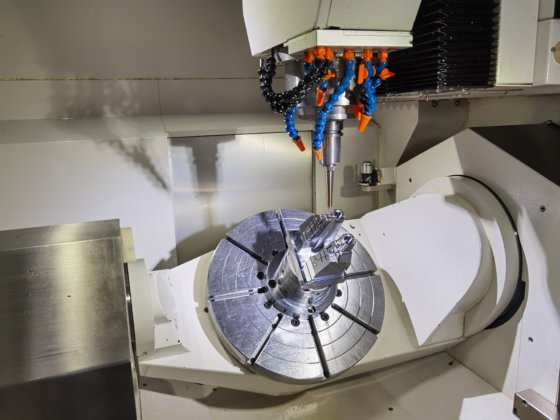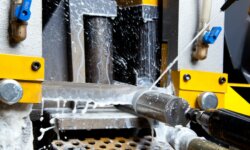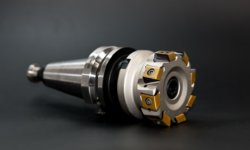Machined parts are everywhere, and it’s easy to see why: CNC machining is suitable for a range of metals and plastics, and machined parts can be fabricated quickly and affordably with no tooling required.
With 3ERP, you can get machined parts and prototypes at fair prices with short lead times, and we have experience working with clients from various sectors. But why should you go for machined parts vs molded or 3D printed parts? Sometimes the choice is obvious, but sometimes it’s harder to decide. And how do you actually design parts for machining, either in-house or outsourced to a manufacturer?
This guide goes over the basics of machined parts: what they are, why companies need them, the best machining materials, typical tolerances for machined parts, how to design machined parts, and more.
What are machined parts?
Machined parts are everywhere. From tiny metal fasteners to aircraft engine components, all sorts of parts have been built using the process of machining. But what exactly is machining, and what therefore is a machined part?
When we talk about machined parts, we mean something more specific than objects built using machinery. We mean specifically parts fabricated using cutting machines such as mills, lathes, and routers. These machines all work in different ways, but their fundamental purpose is the same: using a sharp cutting tool, they cut sections away from a block of material known as the workpiece.
Even within that definition, machined parts can be formed in different ways. The process of machining can be manual, whereby a machinist (a skilled professional operator of machining equipment) handles a machine like a mill to manually cut the workpiece into the desired shape. Or it can be digital, in which case a motorized CNC machine automatically cuts the machined parts according to computer instructions.
Nowadays most complex or custom machined parts are made with CNC machines, but machinists still do manual machining for certain jobs, since it can be faster than creating a digital design and programming the digital machinery.
Machined parts can be metal or plastic (sometimes other materials too), but they must be made from a material that can be cut without drastically deforming.
Sometimes parts are machined after being built with another manufacturing process. For instance, cast or molded items may have certain details or features machined into them at a later stage. These may be described as partially machined parts or post-machined parts.
Why use machined parts?
There are many reasons why companies, product designers, R&D departments, and other professionals might use machined parts, and many of the specific advantages of machined parts are described in the following section.
In short, machined parts have excellent strength, as they are built from solid blocks of material, and they can be made into a wide range of shapes and thicknesses. They can have very detailed features, and they can be made from a very wide range of materials. Small quantities of machined parts can be made quickly, since they do not require tooling, and tolerances can be very tight if machining speeds are reduced.
Companies may also use machined parts because machining is a tried-and-testing manufacturing technique that has been an industry standard for decades. Machined parts are therefore likely to meet industry-specific standards and certifications.
What are the advantages of machined parts?
Machined parts offer certain benefits that may not be possible with, for example, injection molded parts or 3D printed parts. Some of the key advantages of machined parts are listed here.
1. No MOQ
One of the principal advantages of machined parts is the ability to purchase them with no minimum order quantity.
For molded parts, it is necessary to fabricate metal tooling — a process that takes a long time and typically costs tens of thousands of dollars. Machined parts, however, are cut directly from a blank workpiece, which makes it cost-effective to order very small quantities or even one-off parts.
Of course, requiring a very large quantity of (plastic) parts might mean molding is a better proposition. But machining is virtually unique in offering high-quality parts with no MOQ, making it suitable for smaller companies, small production runs, and prototyping.
2. Good prototypes
Some companies choose to order injection molded prototypes, but it is typically only large companies that can afford to do so. The cost of tooling can make prototyping prohibitively expensive.
Machined parts are suitable and affordable as prototypes because they can be fabricated as one-offs. Machining is also much faster than molding, which means R&D departments can quickly iterate several versions of a part, then put it through whatever testing or assessment is required before moving on to production.
The material versatility of machining also means companies can, for example, order machined parts in several different metal alloys or composite plastics to see which performs best under test conditions.
3. Design freedom
Machined parts can have a wide variety of shapes and sizes. This is because CNC machining is not subject to extreme molding design constraints like thin walls and tapering; machined parts can be thick and robust, but their features can also be fine and detailed.
Although machined parts have some limitation when it comes to, for example, internal sections and deep channels, machining still represents one of the most geometrically flexible manufacturing processes.
Molded parts, on the other hand, must have thin walls and conform to more strict design criteria generally.
Even 3D printing process, generally seen as one of the best manufacturing techniques in terms of design freedom, has limitations such as avoiding overhangs. (And extensive support structures may be needed for more complex and sprawling designs, which must be removed with costly post-processing steps.)
4. Quality
Machined parts can be made to a very high standard. Perhaps more importantly, customers can specify tolerances which need to be met by the machinist. This means the machinist or machine operator can take extra time on tight tolerance machining parts and individual features.
While injection molds can also be made to tight tolerances, each individual molding cannot be held to such high standard. Moldings produced toward the end of the mold lifespan may lack the definition of earlier units.
5. Lead times
Machined parts can be fabricated faster than parts made via other production processes like molding.
This is partly due to the absence of labor-intensive tooling, but the manufacturing process itself is also highly efficient: some of the faster machining centers equipped with linear guide rails have rapid rates of around 4,000 centimeters per minute (though parts should not actually be machined at those speeds).
The one-step nature of machining and the speed of CNC machining centers combine to make machined parts some of the fastest to fabricate (in low volumes), reducing lead times for shorter time-to-market and practical rapid prototyping.
6. Alterations
Because CNC machined parts are made from a digital CAD file, it is possible to make changes to that digital design right up until the moment of fabrication.
This is useful during R&D and prototyping, when engineers might want to make fractional adjustments to the machined part or create multiple versions. It also reduces the possibility of waste, since defective parts are less likely to be made.
This is a significant advantage for machined parts over molded parts: tooling cannot easily be changed, and it would be a huge waste of money to create a new mold if a last-minute alteration is required.
7. Strength
Machined parts are cut from solid pieces of material known as blanks, which have typically been cast or extruded. This makes them very strong compared to, for example, 3D printed parts, which can be much weaker along one axis where one layer is built upon the next.
Many machined parts are also stronger than their molded equivalents, since molded parts must have thin walls and are therefore limited in terms of mechanical performance.
8. Surface finish
Machined parts avoid the surface quality issues associated with molding such as flow lines, jetting, and flash at the parting line. With a moderate amount of post-processing, machined parts can be brought to a very high standard in terms of surface finish.
Machining also gives a far superior surface finish to 3D printing, even before any post-processing has been carried out. 3D printing, especially FDM printing, can leave visible layer lines on the surface of the part which must be smoothed over via sanding or chemical treatment. Machined parts do not have these layer lines.
How to design machined parts?
It is always best to employ design for manufacturing (DfM) principles: design parts based on the manufacturing process that will be used. Parts for machining need to be designed differently to, for example, parts for 3D printing.
Fortunately, machined parts are not especially difficult to design — just as long as certain rules are followed. These rules are outlined below.
Undercuts
Undercuts are cuts in the workpiece that cannot be executed using standard cutting tools (because a section of the part is obstructing it). They require special cutting tools — T-shaped ones, for example — and special machining design considerations.
Since cutting tools are made in standard sizes, undercut dimensions should be in whole millimeters to match the tool. (For standard cuts this doesn’t matter, since the tool can move back and forth in tiny increments.)
Undercut width can range from 3–40 mm, depending on the cutting tool, with undercut depth up to twice the width.
If undercuts can be avoided altogether, the machined parts can be made much faster and with less effort.
Wall thickness
Contrary to molded parts, which deform if walls are too thick, machined parts cannot handle especially thin walls. Designers should avoid thin walls, or use a process like injection molding if thin walls are integral to the design.
When machining, wall thicknesses should be a minimum of 0.8 mm (metal) or 1.5 mm (plastic).
Protrusions
As with thin walls, tall protruding sections are difficult to machine, as the vibrations of the cutting tool can damage the section or result in lower accuracy.
A protruding feature should have a height no greater than four times its width.
Cavities, holes, and threads
When designing machined parts, it is important to remember that holes and cavities are dependent on the cutting tools.
Cavities and pockets can be machined into a part to a depth of four times the cavity width. Deeper cavities will necessarily end up with fillets — rounded rather than sharp edges — because of the required cutting tool diameter.
Holes, which are made with drill bits, should also have a depth of no more than four times the drill bit width. And hole diameters should, where possible, correspond to standard drill bit sizes.
Threads, used to incorporate fasteners like screws, do not need to be deeper than three times the diameter.
Scale
CNC machined parts are limited in size because they are fabricated within the build envelope of the machine. Milled parts should measure no more than 400 x 250 x 150 mm; turned parts should measure no more than Ø 500 mm x 1000 mm.
Larger dimensions are possible with larger machines, but this should be discussed with the machinist before fabrication.
Machined part materials
Machined parts can be made from many different materials, including metals and plastics.
However, some materials are easier to machine than others. Very hard materials are difficult to penetrate with a cutting tool and may cause the tool to vibrate more (consequently reducing quality). Very soft materials and materials with a very low melting point may deform upon contact with the cutting tool.
The most common machined part materials are listed below. Other materials can also be machined upon request to the manufacturer.
- Metal: Aluminum, Steel, Stainless Steel (17-4, Inconel 625 & 718), Magnesium, Titanium, Zinc, Brass, Bronze, Copper.
- Plastic: ABS, PC, ABS+PC, PP, PS, POM, PMMA (Acrylic), PAGF30, PCGF30, Teflon, DHPE, HDPE, PPS, PEEK. (Less common: PA GF50, PPS GF50.)
Machined part surface finishes
Machined parts can be treated after machining in order to alter their surface texture and appearance. Finishes can be either functional or cosmetic.
- As-machined: No surface finish added. This is suitable for many internal, non-cosmetic functional components.
- Bead blasted: The bead blasting process involves firing abrasive media at the machined part, leaving it with a matte appearance. The process can be adjusted to give a specific level of roughness. It may not be suitable for fine features, since bead blasting removes material and therefore affects the geometry of the machined parts.
- Anodized: The electrolytical passivation process of anodization is suitable for aluminum machined parts, creating a scratch-resistant, colorful coating. Type II anodization creates a corrosion-resistant finish; Type III is thicker and creates wear resistance in addition to corrosion resistance.
- Powder coated: During the power coating process, powdered paint (in the color of the designer’s choice) is sprayed onto the machined part, which is then baked in an oven. This creates a strong, wear-resistant, and corrosion-resistant layer that is more durable than standard paint coatings.
Machined part tolerances
Machined parts can be made to tight tolerances, which may be necessary for critical mechanical parts that interact with other components. Looser tolerances may be chosen for prototypes and non-mechanical parts.
| Tolerance Standard | |||||||
| Tolerance Lever | Overall Dimension Range | ||||||
| Specifications | <<3, >0.5 | <<6, >3 | <<30, >6 | <<120, >30 | <<400, >120 | <<1000, >400 | <<2000,
>1000 |
| F | ±0.05 | ±0.05 | ±0.1 | ±0.15 | ±0.2 | ±0.3 | ±0.5 |
| M | ±0.1 | ±0.1 | ±0.2 | ±0.3 | ±0.5 | ±0.8 | ±1.2 |
| C | ±0.2 | ±0.3 | ±0.5 | ±0.8 | ±1.2 | ±2 | ±3 |
| V | – | ±0.5 | ±1 | ±1.5 | ±2.5 | ±4 | ±6 |
If you want to know more details, check our guide on standard machining tolerances.
What are the applications of machined parts?
Machined parts are used in virtually all industries, from aerospace to medicine. Some popular everyday and sector-agnostic parts are listed below, followed by applications in specific industries.
Common machined parts:
- Fasteners
- Valve bodies
- Ball joints
- Gears
- Shafts
- Housings
- Brackets
- Rollers
Aerospace
Machinable aerospace parts include prototype engine components, fuel panels, landing gear components, and engine mounts.
Automotive
Automotive machined parts include function testing components such as lighting, engine, transmission & steering systems, as well as one-off custom parts.
Medical
Machined titanium and stainless steel parts include implants, medical devices, and surgical tools such as scalpels.
Consumer products
Machined parts are found in household goods and appliances. Sporting equipment may also be CNC machined, while many machined metal and plastic components are found in consumer electronics. Items such as laptop casings, connectors, and sockets can all be machined.
How to outsource machined parts?
Hardware companies large and small often outsource their CNC machining needs to a specialist. Even for prototypes, it often makes sense to use a third-party CNC machining company over an in-house solution, due to the factory space and human skill required to operate machining equipment.
Choosing a manufacturer to make machined parts can seem daunting, but focusing on the following factors and practices may make it simpler.
- Certifications: ISO certifications in particular are a good guideline for identifying competent machining companies, although they will not inform you of the scope of a company’s abilities.
- Word of mouth: Talk to other hardware companies who have contracted manufacturers in the region and find out their experiences outsourcing machined parts.
- Demand information: Once you have established contact with a company, keep asking questions until you are satisfied that they know how to execute your project. If they cannot give you a clear answer, they probably aren’t a suitable partner for outsourcing.
- Visit factories: If at all possible, visit your potential outsourcing partner to see how they machine parts. In some cases, it may be possible to hire a manufacturing agent to arrange visits to multiple sites in a given region.
- RfQs: Send an RfQ to several shortlisted machining companies to get an idea of who can offer the best price.
When it comes to arranging the manufacture of the outsourced machined parts, it may be helpful to observe the following tips.
- Follow DfM guidelines: Make sure your digital part design follows machining guidelines: no thin walls, holes of limited depth, etc.
- Use universal standards: Submit a complete technical drawing with your digital files to remove ambiguity, and use universal standards to avoid miscommunication.
- NDA: Sign a non-disclosure agreement when outsourcing machined parts. This legally prevents the manufacturer from disclosing or reusing your designs.
- Factor in shipping times: Outsourced parts take longer to arrive than in-house parts, so factor in shipping times if working to tight deadlines.
- Prepare for payment: For first-time orders, manufacturers will probably require payment up-front, though you may be able to order on credit for subsequent orders.
3ERP is a prototyping and low-volume production company with expertise in custom CNC machining services and parts. Order your machined parts with us now.








